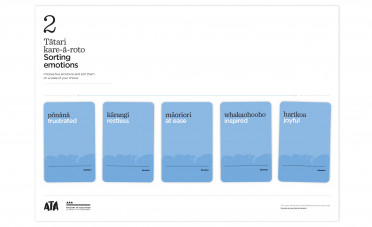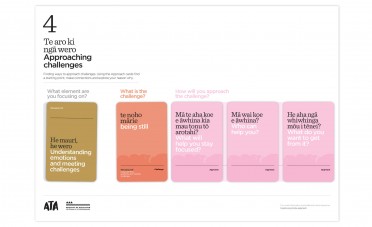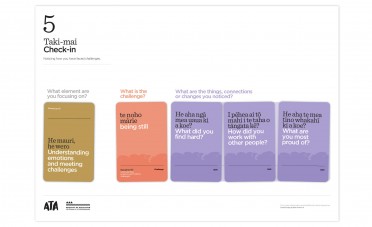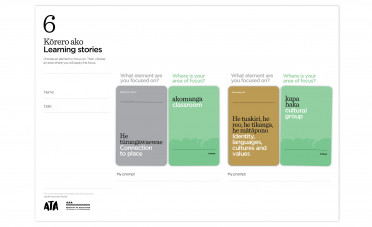Developing strategies Whakawhanake rautaki
Explore the challenges we face and develop strategies to navigate them. Create scenarios, identify challenges, and then develop strategies to navigate them using the Element, Challenge, Context, Impact and Emotion cards.
Ata — Resource collection
This activity is part of the Ata resource collection.
Essential info
- Timeframe:
- 1-2 lessons
- Years:
- 4–10
- Format:
- Individual or groups
Learners will
- Identify and explore areas of focus or interest.
- Identify and explore strengths, weaknesses and areas of improvement.
- Develop a voice and contribute to their learning pathway.
- Develop insight and perspective about understanding different emotions and meeting challenges.
- Develop and apply self-led problem-solving strategies in various scenarios.
Ways to use the resource
- Introduce the activity as a classwide or group exercise over time to ease into the concepts.
- Rather than beginning with a scenario, you can start with:
- An idea e.g., a challenge, context, impact or emotion.
- Building a character. Define the character’s qualities and challenges using the Element and Challenge cards. Then, develop strategies for the character as a group e.g. Who is a role model in your community? What challenge(s) might they face?
- Focus on a particular learner’s challenges and strategies.
- Modify the context, impact and emotion to explore different perspectives.
- Using the blank cards or group discussion, come up with new ideas that are not in the pack.

Instructions
What you will need
Element, Challenge, Context, Impact and Emotion cards.
Developing strategies activity sheets: One per person or group.
Set up
1. Prepare cards
Add or remove Idea cards from each pack to suit the age or developmental stage of learners.
2. Prepare activity sheets
Print or photocopy one Developing strategies activity sheet (simple or advanced) per person or group.
3. Choose a scenario
It helps to have a challenge, impact, or scenario in mind before you start the activity. This could be something happening in the classroom, something happening in the community, or something else topical. Your scenario may mean you pre-select one or more cards before the activity starts.
Activity
Place cards on the activity sheet. Discuss why each selection was made and how it relates to the other cards. We suggest introducing the card types one set at a time as you work through the steps.
1. Select an element
Select an Element card as a primary area of interest or focus.
2. Select a challenge
Select a Challenge card you want to explore or overcome.
Each Challenge card links to an element (noted on the bottom left of the card). Ideally, your Challenge and Element cards should match.
3. Select a context
Select a Context card that represents where this challenge takes place.
4. Select impact(s)
Select one or more Impact cards that represent the things that are getting in your way.
5. Select an emotion
Select an Emotion card that represents how this challenge makes you feel.
The next two steps relate to the advanced activity sheet only.
6. Select solution impact(s)
Select one or more Impact cards that represent the things that could help you overcome this challenge.
7. Select a resolution emotion
Select an Emotion card that represents how you would like
to feel once you overcome this challenge.
Discuss & customise
Discuss the different ways in which you might approach these challenges.
Document your thoughts and plans in a format that suits you.
Using the blank cards or group discussion, come up with new ideas challenges, contexts, impacts and emotions that are not in the pack.
Downloads
-
Ata Blank Cards
Blank Ata cards in an A3-size printable format. Use for capturing ideas and customising the resource.
Pdf, 234 KB
-
Ata Developing strategies cards jpgs
The Ata Developing strategies cards in jpg format.
14 MB
-
Ata Developing strategies cards printable
The Ata Developing strategies cards on print-friendly A3-size pages. Files are in pdf format.
1.8 MB
-
Ata Developing strategies activity sheets
The A3-size Ata Developing strategies activity sheets in pdf format.
Pdf, 102 KB
-
Ata Developing strategies teacher support material
Teacher support material for the Ata Developing strategies activity.
Pdf, 279 KB
Next steps
- Teachers can use insights to inform future lesson plans and areas of learning inquiry.
- Use the Approaching challenges and Learning stories resources to develop relevant learning experiences.
- Once identified, learners can use strategies within relevant Learning areas.




